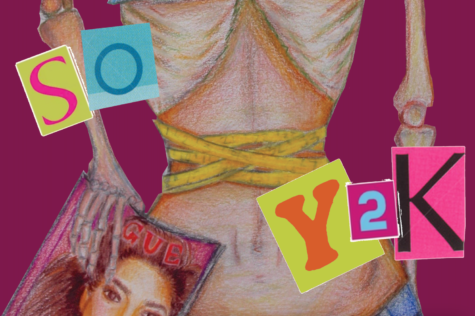OPINION | Y2K fashion trends perpetuate fatphobia
April 26, 2023
(TW: Eating disorders)

The revival of early 2000s fashion, a trend commonly known as “Y2K,” has signaled a cultural shift back to beauty standards that glamorize thinness.
Low-rise bottoms and micro skirts — cuts that fully reveal an individual’s stomach and thighs, respectively — are trademark styles of this trend. Even in a supposed era of body inclusivity, these styles are often advertised by models with slim figures and flat stomachs, a practice that suggests Y2K clothing is only flattering and suitable for slender body types.
So why has Y2K fashion returned when the industry has allegedly entered an era of social consciousness?
Many attribute the resurgence of Y2K trends to the phenomenon of 20-year fashion cycles. Similarly, Clare Varga, the director of beauty at fashion forecasting company, WGSN, said,“The fast pace of modern life coupled with the social and emotional strains of the pandemic have shifted consumer needs significantly towards escapism through the lens of nostalgia.”
However, the return of Y2K signifies more than the ever-changing nature of fashion or beauty standards. This fashion renaissance has brought to light a toxic past and garnered concern from millennials who fear history may repeat itself.
These millennials have taken their concerns to different media platforms, citing the trend’s tendency to cater to skinny bodies, its harmful promotion of unhealthy and unattainable physiques and its glorification of drug abuse. Most prominently, however, are concerns raised regarding the ripple effects its return could have on eating disorder culture.
“We have to be careful with what trends we bring back, especially with this Y2K fashion,” said TikTok user Melynda Rodriguez in a video she uploaded. Rodriguez goes on to recall “starving” herself when she was younger to fit into low-rise jeans and “look cute.”
“In the early 2000s, I dreamed of being thin,” writes Meaghan Wray in her September 2022 Fashion Magazine article that reflects on the effect Y2K culture had on her disordered eating. She said, “I dieted. I hid my body and blamed it for keeping me from the life I wanted. I thought thinness was my ticket to being liked, accepted and desired by the world around me.”
Wray’s perception of thinness as a mechanism to achieve her goals is no anomaly. At a young age, women come to understand that their physical appearance translates into their social and economic success, which changes the prerogative to meet beauty standards from a simple desire to a necessity.
Consequently, women spend much of their adolescence and young adulthood marketing themselves to prospective partners, employers and even friends on the basis of these ideals.
In tandem, these vulnerabilities are exploited by a multitude of enterprises: the healthcare system’s growing profit made off cosmetic surgery and cosmetic dermatology, the media’s advertisement of the weight loss, fitness and diet food industries, and commercial fashion’s primarily exclusive promotion of sample size physiques. Eating disorders and disordered eating are propelled, if not instigated, by capitalism.
The fashion industry, which at times is able to neglect responsibility under the guise of artistic freedom, functions no differently. The industry is aware of the extensive evidence pointing to the negative correlation between women’s self-esteem and their exposure to idealized beauty standards. However, the industry’s priority is profit, even when profit comes at the expense of women’s mental and physical health.
The problematic consequences of Y2K fashion and culture have led many to wonder if it is possible for this trend to exist peacefully, or in a way that reimagines the aspects of its toxicity. Teen Vogue art director, Emily Zirmis, suggests that, “Y2K trends aren’t inherently exclusive of fat people (as long as they come in our size), our ideas of who looks good in them are.”
Zirmis may be right in saying that today, the clothing itself is not discriminative in terms of size availability. However, the trend’s exclusive legacy seems to be entrenched within its modern-day comeback.
The reemergence of Y2K fashion in 2021 and its pervasiveness into 2023 coincides with the return of ultrathin models. The number of plus-size models in the most recent runway season decreased by 24%, according to Tagwalk.
Further, the anti-diabetic medication, Ozempic, has soared in popularity as a weight loss drug — with prescriptions reaching an all-time high this February — regardless of the adverse side effects.
Hopefully, Wray, Rodriguez and other millennials can serve as guides to younger generations through their continued outreach on social media platforms.
Additionally, media literacy has been shown to significantly reduce the internalization of culturally-imposed beauty ideals. An effort to increase media literacy on college campuses could be crucial, as collegiate women are at the highest risk for developing eating disorders.






















Leave a Comment